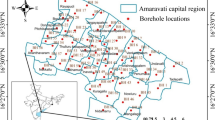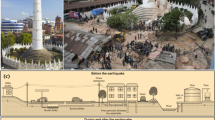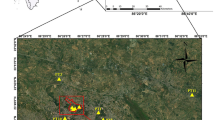Abstract
The understanding of the amplification of seismic waves due to local soil deposits is critical to assessing the ground-level seismic hazards in any region. In the present study, 1D non-linear seismic ground response analysis is carried out for various sites in Dhanbad City of the Indian state of Jharkhand. We have used Standard Penetration Test (SPT) data from eleven sparsely located boreholes spread all over the city. Two earthquake records viz. Nepal (Gorkha) 2015 and the Imperial Valley (1979) earthquakes are adopted as bedrock input motion for the study. The final ground-level responses were estimated for acceleration, strain, shear stress ratio, and Fourier amplitude ratio. The results reveal that various sites in Dhanbad exhibit high to moderate amplification of the bedrock ground motion with a ground acceleration amplification ratio ranging from 1.3 to 3.5. Some sites such as BH-9 (FDC, IIT (ISM)) and BH-10 (Press Club) displayed very high amplification with an amplification ratio ranging beyond 3. The observed amplification variations are correlated with the type and dynamic nature of local soil deposits. The shear strain ratio values varying from 0.25 to 0.6 and 0.14 to 0.28 for Imperial Valley (1979) and Nepal (2015) motions imply the presence of soft and unconsolidated deposits near to the ground surface. The response spectrum obtained from the analysis can be used by structural engineers in designing earthquake-resilient infrastructure. The ground-level accelerations obtained from this study can further aid in the development of detailed microzonation maps for the district.
















Similar content being viewed by others
Availability of Data and Materials
All data generated or analyzed during this study are available upon reasonable request to the author.
References
Alemu BE, Worku A, Wassie GM, Habtesellasie GT (2018) Ground response analysis of representative sites of Hawassa City. In: Geotechnical earthquake engineering and soil dynamics V. american society of civil engineers, Austin, Texas, pp 422–434
Anderson JG, Lee Y, Zeng Y, Day S (1996) Control of strong motion by the upper 30 meters. Bull Seismol Soc Am 86:1749–1759. https://doi.org/10.1785/BSSA0860061749
Anbazhagan P, Kumar A, Sitharam TG (2013) Ground motion prediction equation considering combined dataset of recorded and simulated ground motions. Soil Dynamics and Earthquake Engineering 53:92–108. https://doi.org/10.1016/j.soildyn.2013.06.003
Asimaki D, Mohammadi K, Mason HB, et al (2017) Observations and Simulations of Basin Effects in the Kathmandu Valley during the 2015 Gorkha, Nepal, Earthquake Sequence. Earthquake Spectra 33:35–53. https://doi.org/10.1193/013117eqs022m
Ayele A, Woldearegay K, Meten M (2023) Seismic hazard evaluation using site response analysis and amplitude parameters at Hawassa town. Main Ethiopian Rift Arab J Geosci 16:212. https://doi.org/10.1007/s12517-023-11301-8
Bajaj K, Anbazhagan P (2019) Seismic site classification and correlation between VS and SPT-N for deep soil sites in Indo-Gangetic Basin. J Appl Geophys 163:55–72. https://doi.org/10.1016/j.jappgeo.2019.02.011
Bajaj K, Anbazhagan P (2019) Comprehensive amplification estimation of the Indo Gangetic Basin deep soil sites in the seismically active area. Soil Dynamics and Earthquake Engineering 127:105855. https://doi.org/10.1016/j.soildyn.2019.105855
Bajaj K, Anbazhagan P (2022) Site amplification factors and acceleration response spectra for shallow bedrock sites – application to Southern India. J Earthquake Eng 26:2103–2123. https://doi.org/10.1080/13632469.2020.1754308
Bard P-Y, Campillo M, Chávez-Garcia FJ, Sánchez-Sesma F (1988) The Mexico Earthquake of September 19, 1985—A Theoretical Investigation of Large- and Small-scale Amplification Effects in the Mexico City Valley. Earthquake Spectra 4:609–633. https://doi.org/10.1193/1.1585493
BIS 1893 (2016) Indian standard criteria for earthquake resistant design of structures, part 1-general provisions and buildings. Bureau of Indian Standards, New Delhi.
Biswas SK (2005) A review of structure and tectonics of Kutch basin, western India, with special reference to earthquakes. Curr Sci 88:1592–1600
Borcherdt RD (1994) Estimates of site-dependent response spectra for design (methodology and justification). Earthq Spectra 10:617–653. https://doi.org/10.1193/1.1585791
Borcherdt RD, Gibbs JF (1976) Effects of local geological conditions in the San Francisco Bay region on ground motions and the intensities of the 1906 earthquake. Bull Seismol Soc Am 66:467–500. https://doi.org/10.1785/BSSA0660020467
Borja RI, Chao H-Y, Montáns FJ, Lin C-H (1999) Nonlinear ground response at lotung LSST site. J Geotech Geoenviron Eng 125:187–197. https://doi.org/10.1061/(ASCE)1090-0241(1999)125:3(187)
BSSC (2000) NEHRP recommended provisions for seismic regulations for new buildings and other structures. Building Seismic Safety Council, USA
Cetin KO, Seed RB (2004) Nonlinear shear mass participation factor (rd) for cyclic shear stress ratio evaluation. Soil Dyn Earthq Eng 24:103–113. https://doi.org/10.1016/j.soildyn.2003.10.008
Chen G, ** D, Zhu J et al (2015) Nonlinear analysis on seismic site response of Fuzhou Basin, China. Bull Seismol Soc Am 105:928–949. https://doi.org/10.1785/0120140085
Chowdhuri SN, Singh OP, Mishra OP, Kayal JR (2008) Microzonation study from ambient noise measurement for assessing site effects in Krishnagar area and significance. Indian Min. 61(3–40), 62 (1–4):183–192.
Debnath R, Saha R, Haldar S, Patra SK (2022) Seismic site response analysis of Indo-Bangla railway site at Agartala incorporating site-specific dynamic soil properties. Bull Eng Geol Environ 81:239. https://doi.org/10.1007/s10064-022-02717-9
Desai SS, Choudhury D (2014) Spatial variation of probabilistic seismic hazard for Mumbai and surrounding region. Nat Hazards 71:1873–1898. https://doi.org/10.1007/s11069-013-0984-4
Dhakal RP, Lin S-L, Loye AK, Evans SJ (2013) Seismic design spectra for different soil classes. BNZSEE 46:79–87. https://doi.org/10.5459/bnzsee.46.2.79-87
Ghorbani A, Eslami A, Ghasemi M (2019) Site response analysis of deep sedimentary deposits using electrical resistivity logging; case study: Guilan Province. Iran Geotech Geol Eng 37:4995–5017. https://doi.org/10.1007/s10706-019-00958-2
Godin L, Harris LB (2014) Tracking basement cross-strike discontinuities in the Indian crust beneath the Himalayan orogen using gravity data – relationship to upper crustal faults. Geophysical Journal International 198:198–215. https://doi.org/10.1093/gji/ggu131
Gomez-Bernal MA, Lecea HJG (2012) Empirical attenuation relationship for Arias Intensity in Mexico and their relation with the damage potential. In: 15th world conference of earthquake engineering
Gupta RK, Agrawal M, Pal SK, Das MK (2021) Seismic site characterization and site response study of Nirsa (India). Nat Hazards 108:2033–2057. https://doi.org/10.1007/s11069-021-04767-w
Gupta RK, Agrawal M, Shams R, Pal SK (2023) Seismic site response study of Dhanbad city (India) using equivalent linear analysis complemented by horizontal-to-vertical spectral ratios. Environ Earth Sci 82:291. https://doi.org/10.1007/s12665-023-10985-1
Guzel Y (2023) Site response analyses with different stiffness profiles and input motion variability. Geotech Geol Eng. https://doi.org/10.1007/s10706-023-02662-8
Hanumantharao C, Ramana GV (2008) Dynamic soil properties for microzonation of Delhi, India. J Earth Syst Sci 117:719–730. https://doi.org/10.1007/s12040-008-0066-2
Hashash YMA, Tsai C-C, Phillips C, Park D (2008) Soil-column depth-dependent seismic site coefficients and hazard maps for the upper mississippi embayment. Bull Seismol Soc Am 98:2004–2021. https://doi.org/10.1785/0120060174
Hashash YMA, Groholski DR, Phillips CA, Park D, Musgrove M (2011) DEEPSOIL version Tutorial and user Manual. 98p.
Hashash YMA, Musgrove MI, Harmon JA, Ilhan O, **ng G, Groholski DR, Phillips CA, Park D (2020) DEEPSOIL 7.0, User Manual. IL, Board of Trustees of University of Illinois at Urbana Champaign, Urbana.
Imai T (1977) P and S wave velocities of the ground in Japan. Proc IX Int Conf Soil Mech Found Eng 2:257–260
Imai T, Yoshimura Y (1970) Elastic wave velocity and soil properties in soft soil (in Japanese). Tsuchito Kiso 18(1):17–22
Imai T, Tonouchi K (1982) Correlation of N-value with S-wave velocity and shear modulus. In: Proceedings of the 2nd European symposium of penetration testing, Amsterdam, pp 57–72.
Jishnu RB, Naik SP, Patra NR, Malik JN (2013) Ground response analysis of Kanpur soil along Indo-Gangetic Plains. Soil Dyn Earthq Eng 51:47–57. https://doi.org/10.1016/j.soildyn.2013.04.001
Khan MM, Kumar GK (2020) Site-specific probabilistic seismic hazard assessment for proposed smart city. Warangal J Earth Syst Sci 129:147. https://doi.org/10.1007/s12040-020-01407-y
Kiku H, Yoshida N, Yasuda S, Irisawa T, Nakazawa H, Shimizu Y, Ansal A, Erkan A (2001) In situ penetration tests and soil profiling in Adapazari, Turkey. In: Proceedings of the ICSMGE/TC4 satellite conference on lessons learned from recent strong earthquakes, pp 259–265
Koçkar MK, Akgün H (2012) Evaluation of the site effects of the Ankara basin, Turkey. Journal of Applied Geophysics 83:120–134. https://doi.org/10.1016/j.jappgeo.2012.05.007
Kolathayar S, Sitharam TG, Vipin KS (2012) Deterministic seismic hazard macrozonation of India. J Earth Syst Sci 121:1351–1364. https://doi.org/10.1007/s12040-012-0227-1
Konder RL, Zelasko JS (1963) Hyperbolic stress strain formulation of sands. In: Second pan American conference on soil mechanics and foundation engineering, Sao-Polo Brazil, pp 289–324
Kramer SL (1996) Geotechnical earthquake engineering. Prentice Hall, Upper Saddle River, NJ
NEHRP (National Earthquake Hazards Reduction Program) (2003) Recommended provisions for seismic regulations for new buildings and other structures—Part 1: Provisions. Prepared by the Building Seismic Safety Council for the Federal Emergency Management Agency (Report FEMA 450), Washington, DC
Kumar A, Suman H (2020) Design response spectra and site coefficients for various seismic site classes of Guwahati, India, based on extensive ground response analyses. Geotech Geol Eng 38:6255–6280. https://doi.org/10.1007/s10706-020-01434-y
Lee MKW, Finn WDL (1978) DESRA-2, Dynamic effective stress response analysis of soil deposits with energy transmitting boundary including assessment of liquefaction potential. Soil Mechanics Series, No. 36, Department of Civil Engineering, University of British Columbia, Vancouver, Canada.
Liu Z, Qiao Y, Cheng X, El Naggar MH (2022) Nonlinear seismic response and amplification effect of 3D sedimentary basin based on bounding surface constitutive model. Soil Dyn Earthq Eng 158:107292. https://doi.org/10.1016/j.soildyn.2022.107292
NDMA (2010) Development of probabilistic seismic hazard map of India. Technical report by National Disaster Management Authority, Government of India, New Delhi.
Parihar A, Anbazhagan P (2020) Site response study and amplification factor for shallow bedrock sites. Indian Geotech J 50:726–738. https://doi.org/10.1007/s40098-020-00410-w
Park D (2003) Estimation of non-linear seismic site effects for deep deposits of the Mississippi embayment, Ph.D. Thesis, University of Illinois at urban-Champaign Graduate College.
Pawirodikromo W (2022) Ground motions, site amplification and building damage at near source of the 2006 Yogyakarta, Indonesia Earthquake. Geotech Geol Eng 40:5781–5798. https://doi.org/10.1007/s10706-022-02249-9
Phanikanth VS, Choudhury D, Rami Reddy G (2011) Equivalent-linear seismic ground response analysis of some typical sites in Mumbai. Geotech Geol Eng 29:1109–1126. https://doi.org/10.1007/s10706-011-9443-8
Puri N, Jain A, Mohanty P, Bhattacharya S (2018) Earthquake response analysis of sites in state of Haryana using DEEPSOIL software. Procedia Comput Sci 125:357–366. https://doi.org/10.1016/j.procs.2017.12.047
Rajendran K, Rajendran CP, Thakkar M, Tuttle MP (2001) The 2001 Kutch (Bhuj) earthquake: coseismic surface features and their significance. Curr Sci 80(11):1397–1405
Rastogi BK, Sharma J (2016) Global seismic temporal pattern and enhanced seismicity since 2000. J Ind Geophys 20:316–324
Rathje EM, Kottke AR, Trent WL (2010) Influence of Input Motion and Site Property Variabilities on Seismic Site Response Analysis. J Geotech Geoenviron Eng 136:607–619. https://doi.org/10.1061/(ASCE)GT.1943-5606.0000255
Reddy M, Rajashekara Reddy K, Ch HR, Kumar K (2020) Evaluation and comparison of seismic hazard parameters for Amaravati Region. Disaster Adv 13(8):11–22
Rodgers A, Fowler A-R, Al-Amri AMS, Al-Enezi A (2006) The March 11, 2002 Masafi, United Arab Emirates earthquake: Insights into the seismotectonics of the northern Oman Mountains. Tectonophysics 415:57–64. https://doi.org/10.1016/j.tecto.2005.11.008
Romero SM, Rix GJ (2005) Ground motion amplification of soils in the upper Mississippi embayment. Report no. GIT-CEE/GEO-01–1, National Science Foundation Mid America Earthquake Center.
Rosset P, Puente ADI, Chouinard L, Mitchell D and Adams J (1991) Site effects assessment at small scales in urban areas a tool for preparedness and mitigation. In: 4th international conference on seismic zonation, Standford, California, 25–29 August, 1991
Roy N, Sahu RB (2012) Site specific ground motion simulation and seismic response analysis for microzonation of Kolkata. Geomech Eng 4:1–18
Sastri VV, Bhandari LL, ATRR, Dutta AK (1971) Tectonic framework and subsurface stratigraphy of the Ganga Basin. 12:222–233
Seed HB, Romo MP, Sun JI et al (1988) The Mexico earthquake of September 19, 1985—relationships between soil conditions and earthquake ground motions. Earthq Spectra 4:687–729. https://doi.org/10.1193/1.1585498
Seed BH, Idriss MI (1970) Soil moduli and dam** factors for dynamic response analysis. Berkeley: Earthquake Engineering Research Center, University of California; Rep. no. UCB/EERC-70/10
Seed HB, Idriss IM (1981) Evaluation of liquefaction potential sand deposits based on observation of performance in previous earthquakes. ASCE National Convention Missouri, pp 81–544.
Singh SK, Lermo J, Domínguez T et al (1988) The Mexico earthquake of September 19, 1985—a study of amplification of seismic waves in the valley of Mexico with respect to a hill zone site. Earthq Spectra 4:653–673. https://doi.org/10.1193/1.1585496
Sinha R, Sarkar R (2020a) Probabilistic seismic hazard assessment of Dhanbad city, India. Bull Eng Geol Environ 79:5107–5124. https://doi.org/10.1007/s10064-020-01882-z
Sinha R, Sarkar R (2020b) Seismic hazard assessment of Dhanbad City, India, by deterministic approach. Nat Hazards 103:1857–1880. https://doi.org/10.1007/s11069-020-04059-9
Somantri AK, Mase LZ, Susanto A et al (2023) Analysis of ground response of Bandung region subsoils due to predicted earthquake triggered by Lembang Fault, West Java Province, Indonesia. Geotech Geol Eng 41:1155–1181. https://doi.org/10.1007/s10706-022-02328-x
Srivastava VK, Adwani A, Saxena A, Arora Y (2014) A note on probability of occurrence of largest earthquake in Jharkhand State (India) and nearby region based on Gumbel’s extreme value theory. ujg 2:180–185
Stewart JP (2003) Amplification factors for spectral acceleration in tectonically active regions. Bull Seismol Soc Am 93:332–352. https://doi.org/10.1785/0120020049
Sun JI, Golesorkhi R, Seed HB (1988) Dynamic moduli and dam** ratios for cohesive soils. EERC Report No. UCB/EERC-88/15
Vijaya R, Boominathan A (2022) Modelling the 2D seismic response of the Kutch basin on the Indian Subcontinent. Soil Dyn Earthq Eng 152:107014. https://doi.org/10.1016/j.soildyn.2021.107014
Vucetic M, Dobry R (1991) Effect of soil plasticity on cyclic response. J Geotech Engrg 117:89–107. https://doi.org/10.1061/(ASCE)0733-9410(1991)117:1(89)
Wills CJ, Silva W (1998) Shear-wave velocity characteristics of geologic units in California. Earthq Spectra 14:533–556. https://doi.org/10.1193/1.1586014
Acknowledgements
We are thankful to Central Public Works Department (Dhanbad Central Division, Dhanbad), Central Public Works Department (ISMU Project Division) and Building Works Department (Jharkhand State, India) for providing us with the borehole SPT data for various sites in Dhanbad city. All authors are grateful to Editor in Chief, Mohamed A. Meguid and an anonymous reviewer for their comments which has helped us improve the quality of the manuscript.
Funding
The author(s) received no financial support for the research, authorship, and/or publication of this article.
Author information
Authors and Affiliations
Contributions
R.S proposed and performed various processing steps; R.S. wrote the manuscript; M.A. revised the manuscript and contributed to the interpretation of the results and provided many useful suggestions in the internal review process.
Corresponding author
Ethics declarations
Competing Interests
The authors declare that they have no conflict of interest.
Additional information
Publisher's Note
Springer Nature remains neutral with regard to jurisdictional claims in published maps and institutional affiliations.
Rights and permissions
Springer Nature or its licensor (e.g. a society or other partner) holds exclusive rights to this article under a publishing agreement with the author(s) or other rightsholder(s); author self-archiving of the accepted manuscript version of this article is solely governed by the terms of such publishing agreement and applicable law.
About this article
Cite this article
Shams, R., Agrawal, M. Nonlinear Seismic Site Response Analysis of Shallow Sites in Dhanbad City, Jharkhand, India. Geotech Geol Eng 42, 3515–3538 (2024). https://doi.org/10.1007/s10706-024-02742-3
Received:
Accepted:
Published:
Issue Date:
DOI: https://doi.org/10.1007/s10706-024-02742-3




